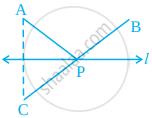Advertisements
Advertisements
प्रश्न
Draw a line segment of given length and construct a perpendicular bisector to line segment using scale and compass
7 cm
उत्तर

Construction:
Step 1: Drawn a line and marked points A and B on it so that AB = 7 cm.
Step 2: Using compass with A as centre and radius more than half of the length of AB drawn two arcs of same length one above AB and one below AB.
Step 3: With the same radius and B as centre drawn two arcs to cut the already drawn arcs in step 2.
Marked the intersection of the arcs as C and D
Step 4: Joined C and D, CD is the required perpendicular bisector of AB.
AO = OB
= `7/2`
= 3.5 cm, ∠AOC = 90°
APPEARS IN
संबंधित प्रश्न
Draw a line segment PQ = 4.8 cm. Construct the perpendicular bisector of PQ.
It is possible to draw two bisectors of a given angle.
In figure, the point C is the image of point A in line l and line segment BC intersects the line l at P.
(a) Is the image of P in line l the point P itself?
(b) Is PA = PC?
(c) Is PA + PB = PC + PB?
(d) Is P that point on line l from which the sum of the distances of points A and B is minimum?
Copy figure on your notebook and draw a perpendicular from P to line m using (i) set squares (ii) protractor (iii) ruler and compass. How many such perpendicular are you able to draw?
Copy figure on your notebook and draw a perpendicular to l through P, using (i) set squares (ii) protractor (iii) ruler and compass. How many such perpendiculars are you able to draw?
Draw an angle of 60° using ruler and compasses and divide it into four equal parts. Measure each part.
Draw the perpendicular bisector of `overline"XY"` whose length is 10.3 cm.
- Take any point P on the bisector drawn. Examine whether PX = PY
-
If M is the midpoint of `overline"XY"`, what can you say about the lengths MX and XY?
Draw a line segment of length 12.8 cm. Using compasses, divide it into four equal parts. Verify by actual measurement.
Draw a circle of radius 4 cm. Draw any two of its chords. Construct the perpendicular bisectors of these chords. Where do they meet?
Draw any angle with vertex O. Take a point A on one of its arms and B on another such that OA = OB. Draw the perpendicular bisectors of `overline"OA"` and `overline"OB"`. Let them meet at P. Is PA = PB ?
